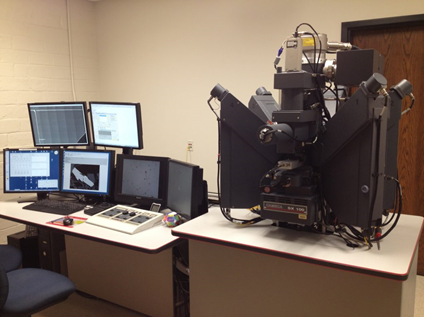Electron Microprobe System; Microbeam SX100 SEM System, Cameca

The Cameca SX100 electron microprobe (EMP) system allows the quantitative determination of the chemical composition of solid organic and inorganic materials at small spatial scales (~ 5μm diameter). It is suitable for quantitative chemical analyses from Be to U of inorganic and organic compounds (only qualitative detection for elements from Be to O) with high spatial resolution elemental mapping and trace element sensitivity down to 100-200 ppm. The SX100 SEM system is a stationary device placed in a specific room with controlled air temperature of ca. 20 oC and the capability for LN2 supply, needed for the regular operation of the device. After the preparation of a petrographic thin section or an epoxy mounted thick section with minimum sample size of ~0.5x0.5 mm, the section should be polished with a diamond paste and coated with a thin layer of evaporated C. The interaction spot dimensions range between 2-10 μm (actual beam diameter) with an electron accelerating voltage at 15 kV and beam current set at 20 nA, while the maximum penetration depth at these conditions is of 2-10 μm (larger spot is required to avoid overheating of samples containing water or P). Some other important equipment specifications are listed below:
- The whole SX100 system includes 5 wavelength-dispersive spectrometers (WDS) and one energy-dispersive spectrometer (EDS).
- The visualisation of the sample in transmitted and reflected light is achieved via an optical microscope with an attached JVC TK-C 1380 CCD camera.
- The electron source is a W filament with a Cameca standard vacuum system.
- High speed back scattered electron (BSE) imaging, as well as EDX elemental distribution maps (faster but less sensitive than WDS) are also possible.
The limitations of the Cameca SX100 EMP system include the essential sampling of the desired solid material and the stability of it under electron bombardment and vacuum conditions. Moreover, it is not possible through WD-EMPA to distinguish between heterovalent cations of the same element (e.g. determination of Fe3+ and Fe2+). For a measurement, the following parameters should be taken into account:
- General description: wavelength-dispersive electron microprobe Analysis
- Application aim: quantitative determination of the chemical composition of solid materials at small spatial scales (~5 μm diameter), ultimate tool for quantitative chemical analyses from Be to U of inorganic and organic compounds (qualitative detection only for elements from Be to O) with high spatial resolution elemental mapping and trace element sensitivity down to 100-200 ppm
- Mobility: stationary
- Equipment specifics:
- Visualisation of the sample in transmitted and reflected light via an optical microscope with an attached JVC TK-C 1380 CCD camera
- W filament as an electron source with a Cameca standard vacuum system
- 5 wavelength-dispersive spectrometers (WDS) and one energy-dispersive
spectrometer (EDS) - High speed back scattered electron (BSE) imaging
- EDX elemental distribution maps (faster but less sensitive than WDS)
High precision sample stage with 0.1 μm stepping capability for automated - Mapping
- Application requirements: LN2 supply, controlled room temperature at ca. 20 oC
- Sample required: yes, either a petrographic thin section or an epoxy mounted thick section with minimum sample size of ~1x1 mm
- Contact required: yes, preparation of thin or thick sections that should be polished with a diamond paste and coated with a thin layer of evaporated C
- Interaction spot dimensions: 2-10 μm beam diameter spot-size at 15 kV and 20 nA with a max. penetration depth of 2-10 μm (larger spot is required to avoid overheating of samples containing water or P)
- Limitations: sampling is essential, materials must be stable under electron bombardment and vacuum conditions
- Set up time: ~ 1 day as calibration of the device by measuring standards is needed for the selected elements. Additionally, high vacuum conditions must be reached inside the microprobe chamber
- Average time for measuring: usually 20-30 sec/element for major elements and ~ 60 sec/element for trace elements, when measuring with WDS; as an example, for 14 selected major and trace elements and a total of 455 measured points, ~ 58 h are needed (measurements can run also overnight)
- Software package: Windows XP
- Output: ASCII files easily convertible to Excel for the chemical analyses (variable data size) and .tif for BSE images (~ 800 KB) and EDX distribution maps (~ 250 KB)
- Contact: Stelios Aspiotis, stylianos.aspiotis"AT"uni-hamburg.de
- Location of the equipment: Mineralogisch-Petrographisches Institut, MPI, (Grindelallee 48, Hamburg)
Cameca SX100 electron microprobe (EMP) system will be available until the end of 2025 (end of UWA I), since from 2026 the Department of Earth System Sciences is not going to further financially support any further annual maintenance, due to budget cuts.
